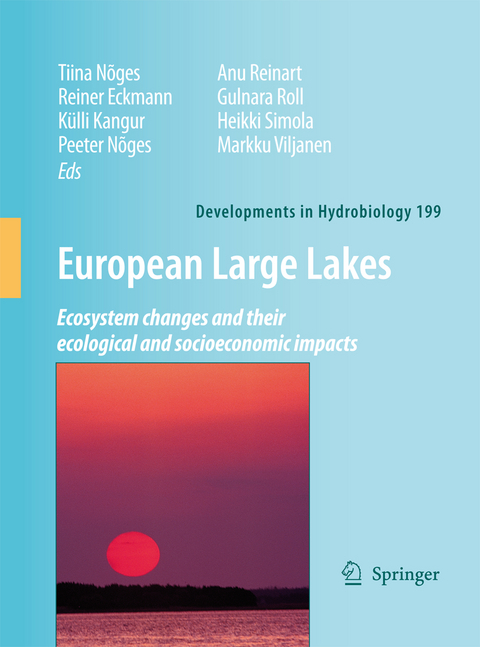
European Large Lakes
Springer (Verlag)
978-90-481-7861-2 (ISBN)
Climate Change and Anthropogenic Impacts on Large Lakes Ecosystems.- Nutrients and phytoplankton in Lake Peipsi during two periods that differed in water level and temperature.- Pollen, diatom and plant macrofossil assemblages indicate a low water level phase of Lake Peipsi at the beginning of the Holocene.- Water level changes in a large shallow lake as reflected by the plankton:periphyton-ratio of sedimentary diatoms.- Changes in spatial distribution of phosphorus and nitrogen in the large north-temperate lowland Lake Peipsi (Estonia/Russia).- Recent trends in Lake Ladoga ice cover.- History of anthropogenically mediated eutrophication of Lake Peipsi as revealed by the stratigraphy of fossil pigments and molecular size fractions of pore-water dissolved organic matter.- Seasonality and trends in the Secchi disk transparency of Lake Ladoga.- Silicon load and the development of diatoms in three river-lake systems in countries surrounding the Baltic Sea.- Critical N:P ratio for cyanobacteria and N2-fixing species in the large shallow temperate lakes Peipsi and Võrtsjärv, North-East Europe.- Phytoplankton nitrogen demand and the significance of internal and external nitrogen sources in a large shallow lake (Lake Balaton, Hungary).- Changes in the water level of Lake Peipsi and their reflection in a sediment core.- Rates of change in physical and chemical lake variables — are they comparable between large and small lakes?.- Increasingly ice-free winters and their effects on water quality in Sweden’s largest lakes.- Phosphorus fractions and alkaline phosphatase activity in sediments of a large eutrophic Chinese lake (Lake Taihu).- Food Web Interactions and Dynamics in Large Lakes.- The impact of the invasive Ponto-Caspian amphipod Pontogammarus robustoides on littoralcommunities in Lithuanian lakes.- Spatiotemporal and long-term variation in phytoplankton communities in the oligotrophic Lake Pyhäjärvi on the Finnish-Russian border.- Plant-associated invertebrates and hydrological balance in the large volcanic Lake Bracciano (Central Italy) during two years with different water levels.- A comparison of zooplankton densities and biomass in Lakes Peipsi and Võrtsjärv (Estonia): rotifers and crustaceans versus ciliates.- Modeling Tools in Large Lakes Research.- Validation of the MERIS products on large European lakes: Peipsi, Vänern and Vättern.- Relations of phytoplankton in situ primary production, chlorophyll concentration and underwater irradiance in turbid lakes.- Models as tools for understanding past, recent and future changes in large lakes.- The ice cover on small and large lakes: scaling analysis and mathematical modelling.- Effects of warmer world scenarios on hydrologic inputs to Lake Mälaren, Sweden and implications for nutrient loads.- Variability of bio-optical parameters in two North-European large lakes.- Contributions of DOC from surface and groundflow into Lake Võrtsjärv (Estonia).- Water Policy and Socioeconomic Aspects of Large Lake Management.- Implications of flexibility in European Community environmental law: exemptions from environmental objectives in the Water Framework Directive.- Analysis of long-term ecological status of Lake Balaton based on the ALMOBAL phytoplankton database.- Towards ecological goals for the heavily modified lakes in the IJsselmeer area, The Netherlands.- Environmental awareness of the permanent inhabitants of towns and villages on the shores of Lake Balaton with special reference to issues related to global climate change.- Highlights of large lake research and management inEurope.
| Erscheint lt. Verlag | 23.11.2010 |
|---|---|
| Reihe/Serie | Developments in Hydrobiology ; 199 |
| Zusatzinfo | VII, 276 p. |
| Verlagsort | Dordrecht |
| Sprache | englisch |
| Maße | 195 x 260 mm |
| Themenwelt | Naturwissenschaften ► Biologie ► Limnologie / Meeresbiologie |
| Naturwissenschaften ► Biologie ► Ökologie / Naturschutz | |
| Naturwissenschaften ► Geowissenschaften ► Hydrologie / Ozeanografie | |
| Technik ► Umwelttechnik / Biotechnologie | |
| ISBN-10 | 90-481-7861-4 / 9048178614 |
| ISBN-13 | 978-90-481-7861-2 / 9789048178612 |
| Zustand | Neuware |
| Haben Sie eine Frage zum Produkt? |
aus dem Bereich


